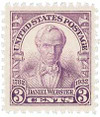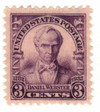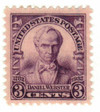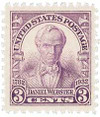
1932 3c Daniel Webster
# 725 - 1932 3c Daniel Webster
$0.40 - $195.00
U.S. #725
1932 3¢ Webster Sesquicentennial
1932 3¢ Webster Sesquicentennial
Issue Date: October 24, 1932
First City: Franklin, Exeter, and Hanover, NH
Quantity Issued: 49,538,500
The state of New Hampshire commemorated the 150th anniversary of Daniel Websters birth in 1932, and requests were made to have a stamp issued in conjunction with the celebration.
While Webster has faded into history somewhat today, he was held in very high regard at the time. Websters first appearance on a U.S. postage stamp was in 1870 on the 15¢ series produced by the National Bank Note Company (U.S. #141). U.S. #725 is the fifth U.S. stamp issued picturing Websters likeness.
The next stamp featuring Webster was issued in 1969 to commemorate the decision in the Dartmouth College Case, a landmark U.S. Supreme Court decision dealing with the governments right to apply the Contract Clause to private corporations. The case settled the nature of public versus private charters, resulting in the rise of American business corporations.
U.S. #725
1932 3¢ Webster Sesquicentennial
1932 3¢ Webster Sesquicentennial
Issue Date: October 24, 1932
First City: Franklin, Exeter, and Hanover, NH
Quantity Issued: 49,538,500
The state of New Hampshire commemorated the 150th anniversary of Daniel Websters birth in 1932, and requests were made to have a stamp issued in conjunction with the celebration.
While Webster has faded into history somewhat today, he was held in very high regard at the time. Websters first appearance on a U.S. postage stamp was in 1870 on the 15¢ series produced by the National Bank Note Company (U.S. #141). U.S. #725 is the fifth U.S. stamp issued picturing Websters likeness.
The next stamp featuring Webster was issued in 1969 to commemorate the decision in the Dartmouth College Case, a landmark U.S. Supreme Court decision dealing with the governments right to apply the Contract Clause to private corporations. The case settled the nature of public versus private charters, resulting in the rise of American business corporations.

















